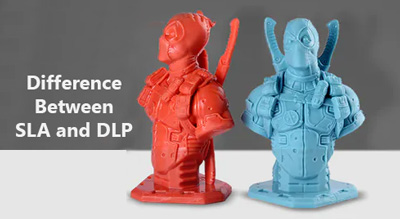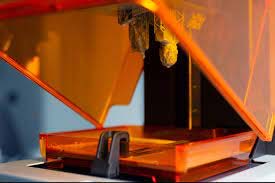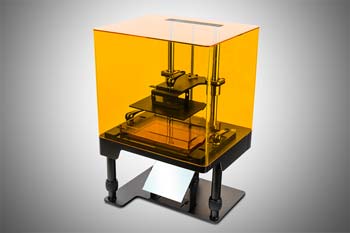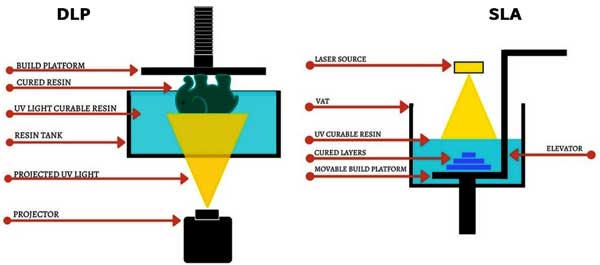
Among all the 3D printing technologies we have today, one of the most widely used materials is resin. Using this substance as the backbone, many mechanisms have come into existence.
3D printing has changed the way we look at technology. It has essentially turned the scientific fantasy of our forefathers into reality.
Two of the most popular 3D printing technologies involving resin are SLA and DLP.
If you are not familiar with these two terms, let us discuss them both in detail here highlighting the pros and cons of SLA vs DLP. Keeping those factors in mind, you can decide for yourself about the better choice between them.
What is SLA?

SLA is short for stereolithography which has immense popularity in the 3D printing industry for its precision, smoothness and other beneficial features. Particularly in the area of additive manufacturing, it has a widespread fandom.
Lasers with high power are used here to make the liquid resin harder and create 3D structures. The method includes photopolymerization in a particular spot of the resin by delivering light through lasers. Each layer forms when the laser sweeps across a container of resin.
This process of transforming photosensitive liquids into solid plastics has been in practice since the early 1980s. It was one of the earliest methods which made 3D printing a reality.
There are two variations of this method – one uses the laser from above and the other one points the laser from below.
Read More: How Does 3D Resin Printer Work? Learn the ins and outs of resin printers in this complete guide!
Advantages of SLA

Precision
How accurate is 3D printing with SLA?
SLA is known to provide much more precision when it comes to 3D printing. Compared to most of its competitors, this process can deliver more accurate details on the desired design or subject. Much of this impressive accuracy roots from its mechanism of creating highly isotropic parts.
High-Quality Prototypes
If you want to upgrade your 3D printing business or projects by presenting prototypes of higher quality to the clients, you can start using SLA to achieve that.
This method is capable of producing fine details like sharp corners and thin walls. It supports printing layers with a minimum thickness of 25 μm and a size of 50 to 250 μm. Using its features, you can also manufacture complicated shapes without trouble.
Read More: What is the Thinnest a 3D Printer Can Print? If you need thin prints, here are the limits you can expect from your printer!
Tightest Dimensional Tolerances
3D printing is known to have greater deviations than other technologies. Compared to CNC machining or injection molding, this additive technology usually has a minimum dimensional tolerance of 0.1mm.
SLA delivers the tightest options in this case by providing 0.127mm tolerance in the first inch and 0.05mm for every inch after that. This is one of the many factors that contribute to the high accuracy of SLA prints.
Smooth Surfaces
Similar to the above features, SLA excels when it comes to smoothness as well. The resulting product of SLA printing often has a surface that is similar to those produced through traditional methods like injection molding, machining and extrusion. Such a flawless finish definitely takes SLA to a higher level than others.
High Build Volumes
You can attain high build volumes by using SLA 3D printing without compromising precision. Its process is highly scalable by default since SLA does not depend on the print resolution for deciding its build volume. You can choose to print a large batch of huge or tiny parts while maintaining the high resolution and details.
Disadvantages Of SLA
Tricky Support Structures
It is a little tricky to use or maintain support structures while working with SLA. When you are building the main design, there can often be the need of such structures for overhangs and steep slopes. These parts are prone to collapsing during the curing and printing stages of SLA.
Limited Color Options
If you are looking for versatility in colors and materials, there is not much to look forward to in SLA 3D printing. It only allows you the most basic shades like black, grey, white and transparent to work with. Therefore, this method involving resins cannot provide an extensive set of design options.
Read More: How Strong is 3D Printer Resin? Is resin right for your 3D project? Here’s how strong resin is compared to other materials!
What is DLP?
DLP stands for Digital Light Processing which is another form of 3D printing using resins. Similar to SLA, it can also be categorized as one kind of vat polymerization technology where the liquid photopolymer is cured or solidified using light. However, DLP uses a different source of light – projector screen!
The digital light projector screen flashes the 2D image of each individual layer in pixels. It is later transformed into 3D where the pixels are turned into voxels – units of a 3D grid. Then the 3D printers compatible with DLP have another light source of LED screens.
Another important player in the lighting arrangement of DLP methods is DMD or digital micromirror device. It is often called the heart of DLP chipsets since there are millions of rotating micromirrors placed within a DMD for directing the light and creating the desired layer pattern.
Advantages of DLP

Fast Printing
DLP has gained massive popularity due to its high speed of printing out the design. Instead of going point to point, DLP goes from layer to layer. It prints out all the points of an entire layer at once. This increases the overall efficiency of a project and thus you can satisfy more clients within the same time period.
Strength
The main material of resin does not possess much strength. It is just a viscous or solid substance that can be molded in various ways. However, DLP happens to be one of the few ways to build pretty strong structures even with resin. It can now provide a strength equal to or higher than injection molding.
Lots Of Colors
Another reason behind so many people relying on DLP for their 3D projects is its impressive array of colors. In addition to the usual neutral colors, you can now use DLP to create 3D models in many other shades using the resins where CMYK pigments have been added commercially.
Low Maintenance
You don’t have to worry too much about maintaining the DLP machines. Their architecture or mechanism is not as complicated as many other similar 3D printing procedures.
As a result, they don’t usually require professional supervision. If a part starts to break down or gets damaged, you can easily find a replacement.
Affordability
Because of its simplistic structure and procedures, the DLP printers are much more affordable than others. Each of these printers comes at a cost that is about four to six times lower than other 3D printers. That is why it gains a top spot in the wishlist of those 3D printing enthusiasts who have a tight budget to run on.
Disadvantages of DLP
Low Accuracy
With all the colors and versatile designs, there comes a catch in DLP.
It cannot provide a good enough precision to the details of your 3D structures. You may see one or more details lacking the sharp features you originally wanted them to have.
As a result, many of the intricacies you wanted to highlight may go unnoticed.
Boxy Finish
DLP should not be the way to go if your project requires a smooth finish on its surfaces. This process works with voxels instead of pixels. Voxels are rectangular 3D units whose shape shows up prominently on the curved areas of your design. However, you can solve this issue by sanding properly after finishing the print.
Comparing DLP Vs SLA

Applications
DLP and SLA are pretty much the biggest stars of 3D printing through vat polymerization or with resins.
Stereolithography is primarily used for computer hardware, medical modeling and prototyping. It can print out 3D models of anatomical parts of humans accurately since the 1990s. Businesses use SLA to create prototypes of their future products for assessing them before launching in public.
DLP is also used to create certain medical models like dental parts of patients, ear shells for hearing aids and more within a few hours. Jewelry manufacturers also use this method to create colorful rings, bracelets, earrings and more using its extensive palette. Some shoe manufacturers also use it for printing midsoles.
Light Source
The fundamental difference in their working procedures is their light source. SLA takes help from a UV laser beam to print out the details on each point of your design. On the other hand, DLP utilizes the UV light from a digital light projector to print out each layer of the 3D model.
Build Volume
The build volume of DLP 3D printing depends on the distance between projectors and the optical window. You can know the number of voxels or pixels from the projector’s resolution. When the projector is pushed closer to the optical window, these pixels get smaller, the resolution goes higher and the build area decreases.
One way to increase the build volume for DLP projects is to use a single HD 4K projector or stack multiple projectors side by side. However, this takes the cost of maintenance much higher.
In contrast, SLA can readily offer impressive scalability since its build volume does not depend on the print’s resolution. You can get the 3D printed model in any size or resolution. That is why you can use SLA to get small parts with intricate details or large parts of high resolution with equal ease.
Accuracy
SLA is capable of materializing the most intricate details of your 3D model with perfection. That is because its process includes printing each point instead of the entire layer at once like DLP. As a result, every bit of the design comes to life with the utmost precision and much more accurately than DLP.
Smoothness
For those of you who constantly work on projects which require a smooth surface throughout the structure, SLA is a much better option. DLP lacks in this regard since the smallest unit of its entire mechanism is rectangular in shape. Therefore, the curved parts come out with a boxy surface instead of a smooth one.
Resolution
The resolution of DLP prints depends on the pixel size which in turn relies on the projector resolution and the projector’s distance from the optical window. Usually, this value is fixed and ranges from 35 to 100 microns. On the other hand, SLA depends on the laser beam’s spot size and its increments used for controlling.
Speed
Compared to SLA, DLP manages to print out the 3D model in a much shorter time. The reason behind its high speed of printing is rooted in the mechanism itself. DLP prints out each layer at a time while SLA focuses on printing out one point of the layer at a time. As a result, the overall time decreases significantly for DLP.
Consistency
If you are thinking of producing 3D structures commercially, DLP happens to be the stronger choice since it can provide higher levels of consistency and reliability. The number of moving parts in these printers is usually less than that of SLA printers. That is why they are less prone to malfunctions while printing.
Maintenance
The structure of DLP machines is not that complicated or sophisticated. As a result, maintaining it doesn’t create too much trouble either. In contrast, you will need to take care of SLA machines much more attentively since they have a complex architecture and their mechanism involves accurate calibration.
Cost
DLP printers happen to be much cheaper than SLA due to their simpler structure and straightforward mechanism. The common printers supporting DLP methods come at the price point of a thousand bucks or less. Comparatively, SLA machines usually come at three or four times the cost of DLP.
Bottom Line – Which One is For You?
As you can see from our entire discussion, there is no clear winner in this SLA vs DLP discussion. They both offer pretty strong features to all 3D printing enthusiasts.
SLA is capable of delivering higher precision, smoothness and build volumes. On the other hand, DLP can provide a wider range of colors, higher speed and an economical price.
So the right kind of 3D printer depends on your preferences and common project requirements. You can pick either considering your individual necessities.